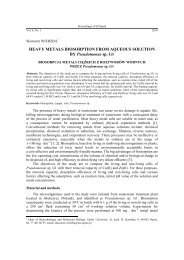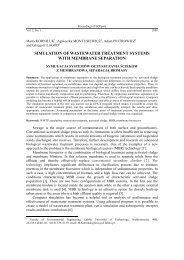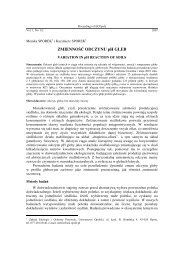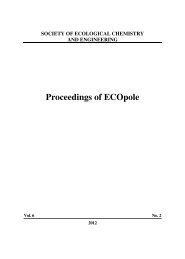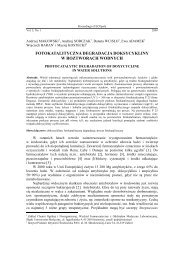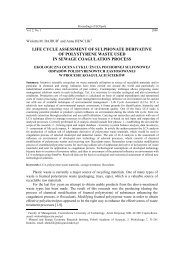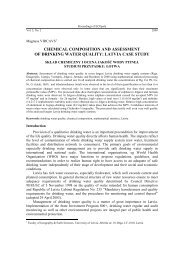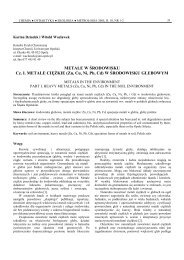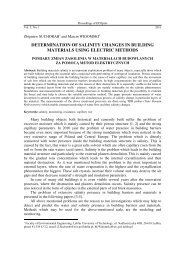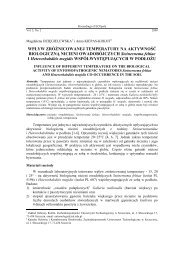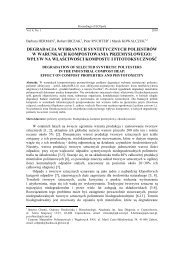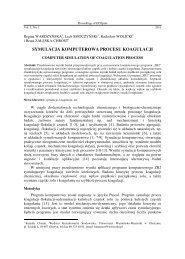disinfective activity of 8-hydroxyquinoline sulfate on moulds
disinfective activity of 8-hydroxyquinoline sulfate on moulds
disinfective activity of 8-hydroxyquinoline sulfate on moulds
Create successful ePaper yourself
Turn your PDF publications into a flip-book with our unique Google optimized e-Paper software.
356<br />
Małgorzata Nabrdalik<br />
c<strong>on</strong>centrati<strong>on</strong>s, the growth <str<strong>on</strong>g>of</str<strong>on</strong>g> tested <strong>moulds</strong> was not observed above the lowest inhibitory<br />
value (GRI = 0) (Table 2).<br />
The growth rate index <str<strong>on</strong>g>of</str<strong>on</strong>g> tested <strong>moulds</strong> in the presence <str<strong>on</strong>g>of</str<strong>on</strong>g> 8-<str<strong>on</strong>g>hydroxyquinoline</str<strong>on</strong>g> <str<strong>on</strong>g>sulfate</str<strong>on</strong>g><br />
Table 2<br />
Mould strain C<strong>on</strong>trol<br />
0.01<br />
C<strong>on</strong>centrati<strong>on</strong> <str<strong>on</strong>g>of</str<strong>on</strong>g> applied chemical [%]<br />
0.1 0.25 0.50 0.75 1.0<br />
Penicillium 25.35 c 23.29 c 23.87 c 23.96 c 24.29 c 20.42 b 0 a<br />
Aspergillus 16.03 e 15.40 e 13.23 d 10.52 c 2.29 b 0 a 0 a<br />
Cladosporium 15.60 e 14.97 d 8.31 c 5.58 b 0 a 0 a 0 a<br />
Stachybotrys 24.37 d 22.70 c 7.23 b 0 a 0 a 0 a 0 a<br />
Alternaria 33.05 d 32.06 c 29.97 b 0 a 0 a 0 a 0 a<br />
Mixed treatment 25.95 e 22.37 c 24.37 d 23.20 c 22.46 c 20.42 b 0 a<br />
lower case - significant differences (p ≤ 0.05)<br />
In the laboratory research the influence <str<strong>on</strong>g>of</str<strong>on</strong>g> 8-<str<strong>on</strong>g>hydroxyquinoline</str<strong>on</strong>g> <str<strong>on</strong>g>sulfate</str<strong>on</strong>g> <strong>on</strong> the<br />
germinati<strong>on</strong> <str<strong>on</strong>g>of</str<strong>on</strong>g> tested mould spores was estimated. The influence <str<strong>on</strong>g>of</str<strong>on</strong>g> the chemical under<br />
study <strong>on</strong> the development <str<strong>on</strong>g>of</str<strong>on</strong>g> spores was estimated <strong>on</strong> the basis <str<strong>on</strong>g>of</str<strong>on</strong>g> the microscopic<br />
observati<strong>on</strong>s, which also enabled determinati<strong>on</strong> <str<strong>on</strong>g>of</str<strong>on</strong>g> the germinati<strong>on</strong> index (GI), taking into<br />
account the grade <str<strong>on</strong>g>of</str<strong>on</strong>g> the hyphae germinati<strong>on</strong> <strong>on</strong> the scale 0-4.<br />
For the following <strong>moulds</strong>: Penicillium, Cladosporium and Stachybotrys the spores’<br />
germinati<strong>on</strong> was inhibited starting from the c<strong>on</strong>centrati<strong>on</strong> <str<strong>on</strong>g>of</str<strong>on</strong>g> 0.5%. There were no<br />
significant differences between the c<strong>on</strong>secutive c<strong>on</strong>centrati<strong>on</strong>s: 0.5; 0.75 and 1%. For<br />
Aspergillus <strong>on</strong>ly 1% c<strong>on</strong>centrati<strong>on</strong> inhibited effectively spores germinati<strong>on</strong>. The value <str<strong>on</strong>g>of</str<strong>on</strong>g><br />
GI was 0 similarly to the values for Cladosporium and Stachybotrys. It was also observed<br />
that in case <str<strong>on</strong>g>of</str<strong>on</strong>g> Alternaria there were no statistically significant differences between the<br />
c<strong>on</strong>centrati<strong>on</strong>s (from 0.1 do 1%). The lowest value <str<strong>on</strong>g>of</str<strong>on</strong>g> GI was obtained when applying 1%<br />
dose (GI = 0.66%) (Table 3).<br />
The ability <str<strong>on</strong>g>of</str<strong>on</strong>g> the spores to germinate in the presence <str<strong>on</strong>g>of</str<strong>on</strong>g> 8-<str<strong>on</strong>g>hydroxyquinoline</str<strong>on</strong>g> <str<strong>on</strong>g>sulfate</str<strong>on</strong>g><br />
Table 3<br />
Mould strain C<strong>on</strong>trol<br />
0.01<br />
C<strong>on</strong>centrati<strong>on</strong> <str<strong>on</strong>g>of</str<strong>on</strong>g> applied chemical [%]<br />
0.1 0.25 0.5 0.75 1.0<br />
Penicillium 24.50 e 14.33 d 7.16 c 4.50 b 1.83 a 0.66 a 0.33 a<br />
Aspergillus 20.50 f 12.50 e 7.16 d 4.33 c 1.16 b 0.33 ab 0 a<br />
Cladosporium 35.33 d 23.16 c 4.00 b 2.83 ab 0.83 a 0.50 a 0 a<br />
Stachybotrys 74.50 d 32.66 c 6.16 b 4.33 ab 1.33 a 0.33 a 0 a<br />
Alternaria 81.33 c 24.33 b 4.50 a 2.50 a 1.66 a 1.16 a 0.66 a<br />
lower case - significant differences (p ≤ 0.05)<br />
The <str<strong>on</strong>g>activity</str<strong>on</strong>g> <str<strong>on</strong>g>of</str<strong>on</strong>g> biocidal chemicals against the microorganisms is a complex and multistage<br />
reacti<strong>on</strong>, which mechanism has not been fully known. Therefore it is difficult to<br />
predict the effect <strong>on</strong> the <strong>moulds</strong> <str<strong>on</strong>g>of</str<strong>on</strong>g> different fungicidal envir<strong>on</strong>ment.<br />
The c<strong>on</strong>ducted research enables to c<strong>on</strong>clude that <strong>on</strong>ly <strong>on</strong> the basis <str<strong>on</strong>g>of</str<strong>on</strong>g> obtained results<br />
c<strong>on</strong>cerning the growth <str<strong>on</strong>g>of</str<strong>on</strong>g> vegetative mycelium and the reacti<strong>on</strong> <str<strong>on</strong>g>of</str<strong>on</strong>g> the spores towards the<br />
specific chemical, it is possible to determine its fungicidal <str<strong>on</strong>g>activity</str<strong>on</strong>g>. In the studies <strong>on</strong>ly



